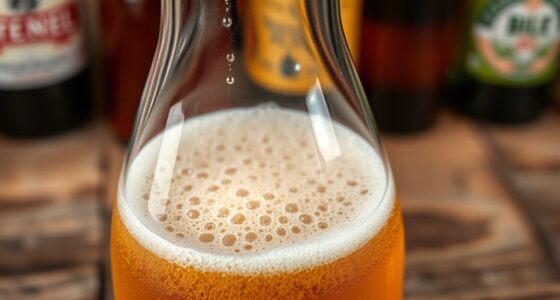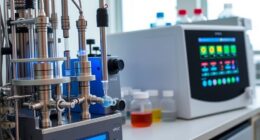In baking, ingredients like leavening agents produce gases that expand and make your baked goods light and fluffy, while sugars and amino acids undergo the Maillard reaction to create browning and rich flavors. Yeast ferments sugars, releasing CO₂ that helps dough rise, and gluten proteins form a flexible network that traps gas for structure. Temperature controls these chemical reactions, ensuring even baking. Exploring these interactions reveals how simple components transform into delicious treats; you’ll discover more as you continue.
Key Takeaways
- Leavening agents like baking soda, baking powder, and yeast produce CO₂ through chemical reactions or fermentation, causing dough to rise.
- The Maillard reaction occurs above 120°C, involving amino acids and sugars, creating browning, flavor, and aroma in baked goods.
- Yeast fermentation converts sugars into CO₂ and ethanol, with enzymes breaking down starches to fuel gas production and dough expansion.
- Gluten forms when water activates glutenin and gliadin proteins, creating an elastic network that traps gases and gives baked products structure.
- Temperature influences reaction rates like Maillard browning and starch gelatinization, affecting flavor development, crust color, and overall baking quality.
The Role of Leavening Agents and Gas Production

Have you ever wondered how baked goods become light and fluffy? It all comes down to leavening agents and gas production. These agents create bubbles within the dough or batter, giving baked goods their airy texture.
Leavening agents produce bubbles that make baked goods light and fluffy.
Chemical leaveners like baking soda and baking powder release carbon dioxide through reactions with acids or heat. Baking soda reacts immediately, while double-acting baking powder produces gas twice—once when wet, again when heated.
Biological leaveners, such as yeast, ferment sugars to produce carbon dioxide gradually, adding flavor and texture.
Mechanical methods, like whipping or creaming, trap air or steam, which expands during baking. These gases—mainly CO2—form bubbles that soften the crumb and increase volume, making your baked treats irresistibly light.
The Maillard Reaction and Flavor Development

The Maillard reaction is an essential chemical process that occurs during baking, responsible for developing the rich flavors and appealing brown color in baked goods. It starts when amino acids react with reducing sugars under heat, forming a glycosylamine. This intermediate rearranges via the Amadori or Heyns pathways, creating flavor precursors. A complex series of 20 to 30 steps produces a variety of compounds, including melanoidins, which give baked goods their characteristic color. The reaction generates diverse flavor notes, such as meaty, caramel, roasted, and nutty aromas, depending on the ingredients. It primarily occurs above 120°C, on the surface where heat and low moisture meet. Proper temperature control enhances flavor development while preventing over-browning or bitterness. The Maillard reaction is responsible for many of the complex flavors and aromas that make baked goods appetizing and visually appealing. Additionally, factors such as moisture content and pH influence the progression of the Maillard reaction, ensuring optimal flavor development.
Yeast Fermentation and Dough Rising

During baking, chemical reactions like the Maillard process create rich flavors and appealing colors, but the rise and texture of your bread rely heavily on yeast fermentation. Yeast, Saccharomyces cerevisiae, metabolizes sugars from flour starches, converting them into carbon dioxide (CO2) and ethanol. Enzymes break down starches into simpler sugars during autolyse, fueling fermentation. The CO2 forms tiny gas bubbles that expand and lift the dough, while gluten networks trap these bubbles, giving structure. As fermentation continues, dough elasticity improves, and flavor compounds develop. Temperature influences fermentation speed: warmth accelerates, cool slows. Proper balance guarantees crucial rise, flavor, and crumb structure, with gluten strength essential for retaining gas and preventing dense bread. Overfermentation weakens gluten, risking collapse despite ongoing gas production. Understanding the precise timing of fermentation is essential for achieving optimal bread quality. Additionally, yeast activity can be affected by factors such as temperature and dough hydration, which are crucial for consistent results.
Gluten Formation: Structure and Texture

Understanding how gluten forms is key to mastering bread texture and structure. When you mix wheat flour with water, glutenin and gliadin proteins combine to create gluten. Water activates these proteins, allowing them to bond and form a flexible, elastic network. Adherence to a timeline during mixing and resting ensures optimal gluten development and final bread quality. The strength and extensibility of this network depend on mixing, kneading, flour type, water amount, and resting time. As you knead, gluten strands become longer and more interconnected, giving dough its elasticity and strength.
Mastering gluten formation is essential for achieving perfect bread texture and structure.
This gluten network traps gases, enabling the dough to rise and develop volume. Proper gluten formation yields a chewy, tender bread with good structure.
Overworking or underdeveloping the gluten can lead to dense or fragile bread. Resting helps the gluten strands align and strengthen, ensuring a desirable final texture.
Temperature Effects on Chemical Changes

Temperature plays a crucial role in driving the chemical changes that transform raw dough into baked bread. As you increase the heat, reactions like the Maillard Reaction accelerate, creating browning, flavor, and aroma.
Higher temperatures hasten these processes, but too much heat can cause the crust to burn before the inside is fully baked. Maintaining an ideal range, around 350°F (176°C), balances moisture retention and chemical reactions.
Rising temperatures also speed up starch gelatinization, thickening the dough and developing structure. Conversely, lower temperatures slow reactions, risking dryness and underdevelopment.
Precise temperature control ensures even heat distribution, promoting proper crust formation and internal texture. Ultimately, temperature influences how quickly and effectively these chemical changes occur, shaping the bread’s flavor, color, and texture. Additionally, understanding the chemical interactions during baking helps bakers optimize their techniques for consistent results.
Interactions of Sugars, Fats, and Liquids in Baking

The interactions among sugars, fats, and liquids are fundamental to shaping the texture, flavor, and structure of baked goods. When you mix sugar with fats, the sharp sugar crystals cut into the fats, creating air pockets that help leaven your batter. During creaming, sugar and fat trap air, making baked goods rise better. Sugars also promote browning and flavor development through caramelization and the Maillard reaction.
Meanwhile, liquids hydrate ingredients, dissolve sugar, and enable gluten formation, which affects dough elasticity. They also help emulsify fats, stabilizing the mixture. The balance of these interactions determines whether your baked product is tender, flaky, or dense.
Adjusting the ratios of sugars, fats, and liquids allows you to control texture, moisture, and flavor, shaping the final outcome of your baked creations.
Frequently Asked Questions
How Does Altitude Affect Baking Chemistry and Ingredient Interactions?
At high altitudes, baking becomes an intense chemical adventure! Gases expand wildly, causing baked goods to rise too fast and collapse.
Liquids evaporate instantly, drying out your treats. You need to modify recipe ingredients, like reducing leaveners and adding liquids, and crank up the oven temperature.
These dramatic changes guarantee your baked goodies turn out just right, despite the fierce altitude challenges.
Can Ingredient Substitutions Alter Expected Chemical Reactions in Baking?
Yes, ingredient substitutions can definitely alter expected chemical reactions in baking. When you replace ingredients like sugar, liquids, or leaveners, you change moisture, acidity, or gas production, which impacts browning, leavening, and texture.
For example, swapping water for carbonated drinks adds extra gas, boosting rise. You need to adjust other ingredients accordingly to maintain proper chemical balance and achieve the desired results in your baked goods.
What Role Do Ph Levels Play Beyond Gluten Weakening or Strengthening?
Think of pH as the conductor of your baking orchestra, guiding more than just gluten. You influence enzymatic activity, affecting starch breakdown and sugar availability.
pH also impacts leavening timing, color, and texture development, ensuring your baked goods are perfectly tender, golden, and flavorful. By balancing pH, you control Maillard browning and moisture retention, turning simple ingredients into bakery masterpieces that delight the senses beyond just gluten’s strength or weakness.
How Do Preservatives Impact Chemical Reactions During Baking?
You might wonder how preservatives impact chemical reactions during baking. They can influence oxidation, affecting flavor and safety, and sometimes react chemically, like sulfites altering dough properties.
Preservatives can also affect fermentation by inhibiting yeast or bacteria, which impacts bread’s texture and volume.
While generally non-reactive with ingredients, they must be carefully dosed to avoid changing the product’s odor, color, or taste, ensuring both safety and quality.
What Are the Effects of Baking Time Variations on Flavor and Texture Development?
Baking time variations markedly impact flavor and texture. If you underbake, your baked goods may taste doughy and have a dense, gummy texture.
Overbaking can cause bitterness and dryness, making your product crumbly or tough. Proper timing develops rich flavors through Maillard reactions and caramelization, while also ensuring a tender, balanced crumb.
Adjusting baking time allows you to control the final taste, appearance, and mouthfeel of your baked creations.
Conclusion
Now that you know how ingredients dance together in baking, you can think of your kitchen as a chemistry lab where magic happens. Every rise, color, and aroma is a tiny masterpiece of chemical reactions. With this knowledge, you’ll turn simple ingredients into delicious art, like a painter with a palette. So, embrace the science behind baking—it’s your secret recipe to creating baked goods that delight both the senses and the mind.









